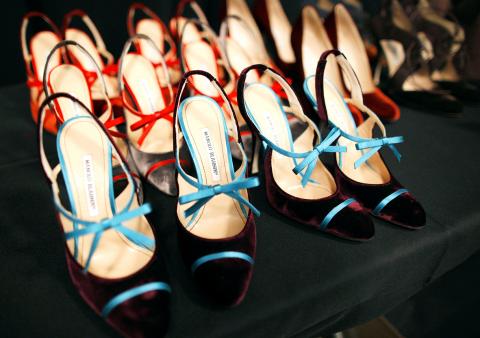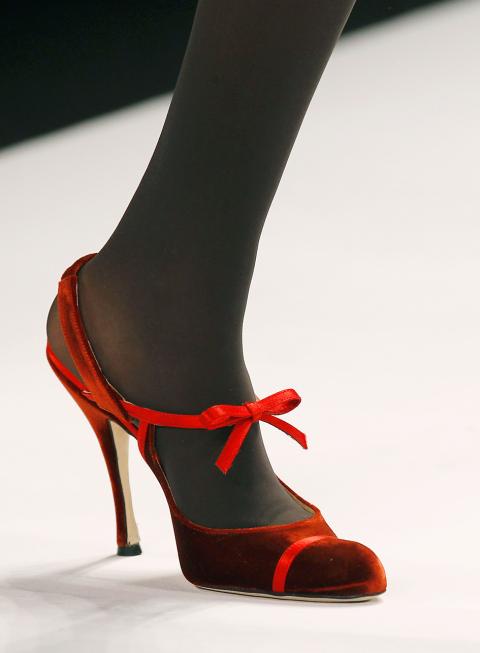This is the tale of the little stiletto that could, a shoe that in the long-ago days of the luxury-goods boom scampered to the top of a rarefied heap. It was just a handful of years ago that the name of Manolo Blahnik, a 68-year-old London cobbler born in the Canary Islands, was familiar only to hardcore fashion hunters and residents of zip code 10021.
Then a funny thing happened: Sex and the City.
As man-crazy as the character Carrie Bradshaw was on the long-running series, she was just as obsessive about what Vanity Fair once termed every woman’s favorite phallic symbol, shoes. Lust for footwear seldom featured as a continuing television plot line before the show came along. Yet such was the shoe-mania of the character played by Sarah Jessica Parker that, merely by name-checking Manolo Blahnik, she made his a household name.

Photo: Reuters
One sign of the familiarity US women developed with Blahnik’s classically styled shoes — so comfortable, some claimed, you could wear them to scale Everest — was a 2007 survey by Women’s Wear Daily and the trade journal Footwear News. In it, 37 percent of the 2,000 consumers canvassed about their buying habits conceded that they’d willingly bungee-jump off the Golden Gate Bridge in exchange for a lifetime supply of Manolos.
And if they had, they probably would have met Manolo on the way down.
Soon after the 2007 survey appeared, Blahnik’s name and label took a style dive, his often kittenish designs supplanted by the more aggressive efforts of a new crop of shoemakers, people like Nicholas Kirkwood, Brian Atwood and Christian Louboutin.

Photo: Reuters
It was Louboutin who most effectively hijacked Manolo Blahnik’s thunder and a chunk of his market, using an arsenal of gaud and ostentation, shoes that came studded, strapped, buckled and fur-covered and that were also made instantly identifiable by his signature red soles. (The same soles have embroiled him in a long-running trademark infringement dispute with the fashion house Yves Saint Laurent.)
Unlike Blahnik, Louboutin seemed to revel in borderline vulgarity. What, after all, is a red sole but an update on the comedian Minnie Pearl’s custom of wearing her hat with the price tag attached? “It was a chic idea for a minute,” said George Malkemus, president of Manolo Blahnik USA. “You wore a red sole, and everyone knew you spent US$1,200 or US$1,400 for your shoes. And I would say there was a period when certain customers abandoned us and moved into that world.”
Even among those closely associated with the iconic Blahnik shoe there was a sense that the tide had shifted. A time came, Parker said, “when Manolo wasn’t defining the aesthetic,” when Blade Runner styles took over from smart patent pumps, and wearing Manolos was almost like announcing one had turned in one’s coquette card and started taking style cues from Judge Judy.
Blahnik, notoriously indifferent to fashion trends, stayed true to an aesthetic that he said was formed in his 1950s boyhood by women like Audrey Hepburn and the ultra-elegant model Dovima, nee Dorothy Juba. “The gimmicky thing I’m not very keen on,” Blahnik said earlier this month from London. “I’ve never been tempted to do these hideous furniture shoes.”
But fashion, as we all know, is nothing if not fickle; Heidi Klum is merely reporting fact when she notes each week on Project Runway that one day you’re in and the next day you’re out. So it should come as no surprise that, suddenly, signs are everywhere that Blahnik is back in style.
When Kate Moss married last summer, she was shod in a pair of classic Manolos. When Parker was photographed in a multipage pictorial for last August’s Vogue, she wore Manolo’s BB pump exclusively. When Marc Jacobs showed his spring 2012 collection last month in New York, he paid sly homage to Manolo and the designer’s classic high-heel Mary-Janes.
And at the recent spring 2012 shows in Paris, the style of footwear dominating runways had a lot less in common with the stunt shoes that held sway in recent seasons — the ones compulsively name-checked by Real Housewives and in songs by J. Lo, and that garnered Louboutin full-scale profiles in The New Yorker and Vanity Fair — than with the simple and ladylike shoe Blahnik has designed since his competitors were in their teens.
“In the fight for the shoe summit,” Parker said, Manolo is suddenly on top again.
The reasons seem clear. Not only did “the cult of the ugly shoe have to end,” as Andre Leon Talley, a contributing editor of Vogue, recently noted, but unbridled ostentatious spending has come to look a lot less chic when nearly one in 10 Americans is unemployed.
“Fashion had to turn on its ugly heel and return to beautiful shoes,” Talley said, citing among the appealing elements of Manolo Blahnik shoes their sleek lines and absence of gimmickry.
“They’re a staple, something you have to have in your refrigerator, like butter or milk,” he said — or Champagne and caviar, anyway.
“Manolo’s shoes are very much in the spirit of this moment’s clothes, pared down, with simple lines, and I hate to say ladylike, but classic,” said Linda Fargo, the senior vice president for women’s fashion at Bergdorf Goodman, where recent deliveries of a particular Manolo Blahnik pump sold out so fast, the store was forced to institute a waiting list, that forgotten symbol of 1990s excess.
“We do a very, very strong business in his shoes,” Jonathan Joselove, senior vice president and merchandise manager for Neiman Marcus Stores, said by phone from Paris, adding that the stores have difficulty keeping certain Manolos in stock, despite a cost of US$600 or more a pair. “He knows how to make a woman look beautiful,” Joselove said.
Understandably, most people might struggle to understand the irresistible allure of a shoe whose cost is equal to about a quarter of the average US household’s annual clothes budget for a family of four. Yet for retail analysts, the current rush on Manolo Blahnik shoes is an encouraging sign for the economy, over all.
“The upper end of the market is driving much of the growth” in retail, said Marshal Cohen, chief analyst at the NPD Group, a consumer research firm. And surprisingly, despite a near constant din of doomful economic news, that market is by all accounts robust.
“Luxury is strong,” said Mary Lou Quinlan, the chief executive of Just Ask a Woman, a marketing company with clients like Clairol and GlaxoSmithKline. “There’s an element among women who are still doing well in their jobs of, ‘I deserve it, I need it, I’ve got to have my fix.’”
As recently as a year ago, that shoe fix might have been delivered by Jimmy Choo, Sergio Rossi, Pierre Hardy, Brian Atwood, Walter Steiger, Nicholas Kirkwood or any of the other high-end players who got in on the lucrative market in keeping women well shod.
It might have had bondage straps or menacing spikes, ornamental elements that made it seem, during one recent season, as if Miuccia Prada had found inspiration in Rosa Klebb, Ian Fleming’s Cold War villain who secreted stiletto blades in her soles.
On certain Louboutin shoes, heels rose above 15cm, the better to accommodate thick wedges and platforms and to justify prices that crept toward US$2,000 a pair. “Louboutins were just so much cooler, spikier and more high-fashion,” said the writer Molly Jong-Fast, a self-professed shoe fiend. “If you’re going to spend US$800 for a pair of shoes, you want something cutting edge, not something you’ll see everyone wearing at shul.”
Curiously, the re-emergence of Blahnik’s restrained “classic” styles counters an apparent trend sometimes noted by footwear historians: The more depressed the economy, the more vertiginous the shoe. “But this recession has dragged on so long” that the playful vulgarity of wearing sinister and gravity-defying shoes is seen as unseemly, said Elizabeth Semmelhack, senior curator of the Bata Shoe Museum in Toronto. “If the first wave was an overexuberant expression of wealth, the next is of ostentatious restraint.”
Or, as Mary Lou Quinlan of Just Ask a Woman said, “It’s tacky to strut around in your red-soled shoes when other people are trying not to get a pink slip.”
Yet it’s style, and not political correctness, that is driving a return to Manolo Blahnik. “For classic, timeless Jackie O dressing, it’s always back to Manolo,” said Lisa Bytner, a Manhattan publicist who owns 20 pairs. “I bought Louboutins to be in on the platform fad and now they’re sitting in the closet because they hurt.” In Manolos, say fans like Bytner, “I can jog down the street and run for a taxi.”
Why bother, Louboutin said in a recent interview timed to coincide with the release of a lavish 304-page coffee-table book (Rizzoli, US$150) celebrating his designs? “I don’t have the pretensions that they are there to fulfill every need that people have,” he told the New York Post. “Who wants to run, anyway, really?”
Arriving for her Vogue shoot last spring, Parker entered a dressing room filled with the latest styles and a wall of shoes secured for the sitting by Tonne Goodman, a seasoned editor at Vogue. “I walked in and looked around and saw all these shoes, and then I spotted the Manolos and it was like water in a desert,” Parker said.
“I was just so excited to see a simple black pump.”

Before the recall election drowned out other news, CNN last month became the latest in a long line of media organs to report on abuses of migrant workers in Taiwan’s fishing fleet. After a brief flare of interest, the news media moved on. The migrant worker issues, however, did not. CNN’s stinging title, “Taiwan is held up as a bastion of liberal values. But migrant workers report abuse, injury and death in its fishing industry,” was widely quoted, including by the Fisheries Agency in its response. It obviously hurt. The Fisheries Agency was not slow to convey a classic government

Not long into Mistress Dispeller, a quietly jaw-dropping new documentary from director Elizabeth Lo, the film’s eponymous character lays out her thesis for ridding marriages of troublesome extra lovers. “When someone becomes a mistress,” she says, “it’s because they feel they don’t deserve complete love. She’s the one who needs our help the most.” Wang Zhenxi, a mistress dispeller based in north-central China’s Henan province, is one of a growing number of self-styled professionals who earn a living by intervening in people’s marriages — to “dispel” them of intruders. “I was looking for a love story set in China,” says Lo,

It was on his honeymoon in Kuala Lumpur, looking out of his hotel window at the silvery points of the world’s tallest twin skyscrapers, that Frank decided it was time to become taller. He had recently confessed to his new wife how much his height had bothered him since he was a teenager. As a man dedicated to self-improvement, Frank wanted to take action. He picked up the phone, called a clinic in Turkey that specializes in leg lengthening surgery — and made a booking. “I had a lot of second thoughts — at the end of the day, someone’s going

The next few months will be critical in determining the future of the Taiwan People’s Party (TPP). Following party founder Ko Wen-je’s (柯文哲) arrest in September last year, Huang Kuo-chang (黃國昌) effectively became the de facto face of the party and officially became chairman in January. While Ko frequently criticized the ruling Democratic Progressive Party (DPP) and insinuated sinister intentions on the part of the DPP’s New Tide faction, his era was largely defined by the TPP slogan “rational, pragmatic, scientific,” albeit defined largely by his definition of what that meant. The tone and language used by the TPP changed dramatically